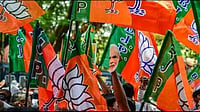Kitaab Ghar (Home of Books) at the Lal Chowk Srinagar was once a popular hangout of Kashmiri language writers and litterateurs. With half shutter up, this bookshop continues to sell books on Kashmiri literature, but hardly has any customers. The bookshop is run by the Jammu and Kashmir Academy of Art, Culture and Languages.
The bookshop’s collection is also dwindling with time. Among the books prominently displayed is a Kashmiri translation of Intizar Hussain from Pakistan, who was among the finalists of the Man Booker Prize in 2013.
The salesperson, Farooq Ahmad, says the shop has only two translated works of Kashmiri. One is a translation of Kashmiri poet Habba Khatoon’s poems, and another is a translation of Tareikh-e-Hassan by Prof. Shafi Shauq. The latter was originally authored by Peer Hasan Shah Khoihami (1832-98) and is considered a masterpiece of Kashmir’s history. Shah was the first Kashmiri historian to have productive contact with European scholars who were, according to Shauq, fervently busy exploring all aspects of Kashmir including the region’s history.
At the Residency Road, Sheikh Ajaz Ahmad, owner of Gulshan Book Store, says most of the translated published work from Kashmiri to English is done by Prof. Shauq, and stocks almost all these translations. The shop has also copies of the Standard Manual of the Kashmiri Language and A Dictionary of the Kashmiri Language, both written by British civil servant and linguist George Abraham Grierson in the first half of the 20th century. “But people usually don’t buy them. Only some scholars interested in the Kashmiri language ask for such books,” he says.
From the 1940s onwards, Kashmiri writers have translated a bulk of classic Russian literature into Kashmiri but those books, including the Kashmiri translation of War and Peace (Jung tai Aman) by Muzaffer Azim or Ghulam Nabi Khayal’s highly acclaimed translation of Rubaiyat of Omar Khayyam, are out of the print and were not found in any bookshop in the Valley.
In 1989, after the insurgency erupted in the Valley, life changed for everyone, and no one knows what would happen to him on a routine day. Ironically, the situation saw some great literature being churned, both in Kashmiri and other languages. Kashmiri writers writing in the Kashmiri language have reflected on the everyday reality of Kashmir, though detractors argue that not much has been written on Kashmir by Kashmiri writers, poets and short story writers writing in the native language.
In contrast, Kashmir writers writing in English are being praised for their Kashmir novels. While Basharat Peer’sCurfewed Night, Mirza Waheed’s The Collaborator, Feroz Rather's debut fiction novel, The Night of Broken Glass and Farah Bashir’s Rumours of Spring are considered must-read books on Kashmir, there is hardly any recognition of writers writing in Kashmiri language. Even doyen of Kashmir literature Akhtar Mohiuddin (1928-2001), often called 'Guy de Maupassant of Kashmiri literature', is relatively unknown to anyone beyond Kashmiri literary circles.
Kashmir language writers are often dismissed by the new generation for preferring to write Kashmiri romantic novels and poetry rather than reflecting on the painful situations in the Valley. Ironically, those who accuse Kashmiri writers writing in Kashmiri of ignoring the Valley’s raging conflict cannot read Kashmiri.
Also, many here argue that translation and creative writing are two different things, but translation is one of the ways to provide wider readership to creative expression in a particular language. What is critically important for the language and its existence is how much creative literature is produced in that language. In that respect, Kashmir is at present struggling very hard against local and global challenges.
Locally, the language has no takers. Only some teaching posts are available for a person, who deals and dabbles in the Kashmiri language. Also, across Kashmir Valley, middle-class families prefer their children speaking either Urdu or English. Children don’t talk in Kashmiri, and even in crèches and schools, English is considered the only choice for upward mobility.
While Kashmiri script is like the Urdu script (Nastaliq) and those familiar with Urdu can read Kashmiri after some effort, there is a tussle over which of these should be the official script of the language. The translation of the Constitution of India by late GN Gauhar is still pending the Law Ministry’s approval as the author had translated it in Nastaliq script.
Historically, Kashmiri is as old as the English language. Shafi Shauq, a Sahitya Academy-award-winning Kashmiri poet and former head of the department of Kashmiri at Kashmir University, has been arguing that Kashmiri is different from other South Asian languages. Languages of Bulgaria and Albania are more closely related to Kashmiri than Hindi or Urdu. In 2010, Prof. Shauq produced a Kashmiri dictionary after working on it for eight years, Kaesher Lugaat (Dictionary of Kashmiri Language), spread over 1,400 pages with over one lakh entries in almost every field.
When asked about the importance of translation and how has it enriched Kashmiri, Prof. Shauq says, “It is now an established truth that language is speech not it's written form. The occurrence of literature is a later development in the history of civilisation. Kashmiri, too, has had a continuity since times memorial.
Written literature began in the 14th century when writers like Sheikh Noorud Din got influenced by literature in Sanskrit and Persian. The language emerged as a written language with literature in it. Since then, mainly translation enriched our language.” He adds, “Mir Abdullah Baihaqi and Mehmood Gami did pioneering work in this direction. Almost all masterpieces of Persian literature are translated in Kashmiri. Even classics of Sanskrit literature have been accomplished.”
Prof. Shauq says after 1947, numerous world-class works like Greek plays, Shakespearean plays, Tolstoy's novels, Chekhov's plays and stories Kafka, and other works were translated into Kashmiri. "It is because of these translations that literature in various genres appeared in the Kashmiri language. However, no serious work has been done in translating Kashmiri into English and other modern languages,” he informs.
Pioneering work has been done by the Europeans. Karl Burkhard translated Mehmood Gami's Yousuf Zulaikha Mathnavi in 1874. George Abraham Grierson rendered many works in English. “Had this process continued, our entire literature might have got rendered into European languages.
I have myself tried to translate many works of writers from the 14th century to young writers of today. All my work in translation is published, yet I am sorry to have to say, that no one knows about it, leaving aside the bitter fact that I am yet to find a reader,” he says.
Kashmiri writers who write in English feel the lack of translation is keeping a treasure trove of Kashmiri literature away from the world. “Kashmiri literature dates to Chaucer’s time. Our professor used to say that Lal Ded was his contemporary. They wrote around the same time. While, I, Lalla: The Poems of Lal Ded translated by Ranjit Hoskote exists, there is so much literature and poetry limited to a very niche set of readers. We are sitting on a treasure cove,” says author Farah Bashir. “Such a rich literary heritage is so little known to the world outside. It’s our loss,” she adds.
Since Lal Ded, there have been many mystic and Sufi poets like Khawaja Habibullah Nowsheri and Shams Fakir who have contributed to Kashmiri poetry. In the early 20th century, the likes of Ghulam Ahmad Mahjoor and Abdul Ahad Azad were harbingers of modernism in Kashmir.
They produced the bulk of literature in Kashmiri that was culturally in tune with the modern times. In the early 1950s, short stories were taken up in a big way by Kashmiri writers, Dina Nath Nadim, Rehman Rahi, Amin Kamil, Ghulam Nabi Khayal, Bansi Nirdosh and others.
“One of the reasons is the popularity of poetry as a genre and the near absence of the novel in Kashmiri. The novel is a popular genre among those who read literatures in translation. To translate poetry, you need very good translators,” says Abir Bazaz, Assistant Professor of English at Ashoka University. Bazaz argues there have been a few good short story writers in Kashmiri whose stories were published in anthologies. “Short stories can easily find a wider audience if translated into other languages. But when partly the quality of writing is uneven and partly Kashmiri, it does not have many good translators," he adds.
Sangam House had organised a workshop for translators in Kashmir and small steps like these could prove transformative. Yet, the real reason for this situation is the state of the Kashmiri language that unites the different communities of Kashmir across caste, class, and religion, has also been the most neglected after it lost its status as a medium of instruction in 1953.
“The great Kashmiri poet Amin Kamil put it aptly: Kaeshir-i saet Kashir saeri/Nate waeraan-ik haeraan kaav (We are Kashmiris because of Kashmiri/Without it, crows lost in wilderness),” says Bazaz.
Many argue that cosmetic efforts to save the Kashmiri language have made a bad situation worse and it has not helped poets and authors in any way. Another problem is the involvement of the State in the promotion of the Kashmiri language, which has made the space of literature difficult to imagine outside spaces such as the Sahitya Akademi, and Jammu and Kashmir Academy of Art, Culture and Languages.
Even though these institutions have done some remarkable work, there is a downside. “Kashmiri language remains connected to feelings of humiliation and shame, but the effort towards more cultural freedom in Kashmir could turn the situation around and Kashmir could have a new flowering of Kashmiri literature which could then also find good translators," says Abir Bazaz.


























